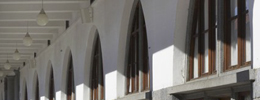

Presenter's guide
Oral presentations
For oral presentations a computer projection system will be provided in the lecture hall. To ensure smooth and timely progression of the sessions, presentations should be submitted in advance of the relevant symposium. Presenters can either send the presentation by e-mail, or submit it on a suitable electronic medium (CD, USB drive) either at the time of registration or on the day of the symposium, but no later than 15 min before the start of the session. Presenters should name the presentation file by their last name. Using the computer available in the lecture hall is a preferred method of presentation. If a presenter plans to use his/her own laptop, they should notify the organizers in advance of the session. Advance requests are required also for slide or video projection.
To ensure timely and successful sessions, presenters are requested to be on time and to adhere to provided time limits.
Poster presentations
1/ Poster presentation schedule
All SNC'13 participants with accepted abstracts will present their work in the form of poster presentations. Presenters are advised to mount their posters on Friday morning and leave them up until the closing of the SNC'13. The presenters are requested to be present and available for questions and discussion at the specified time-slot (A - Friday 12:00-13:30; B - Saturday 12:00-13:30; C - Sunday 12:00-13:30). The list of posters with corresponding poster numbers and poster session times is available at the end of the SNC'13 programme page.
2/ Instructions for preparing effective posters
SiNAPSA Conference is a multidisciplinary event. Remember that several people of varying degrees of interest and experience may be viewing your poster. Therefore, you will want to make your points as complete and brief as possible.
There are no strict requirements regarding poster size. The poster boards allow posters up to 120 cm tall and 90 cm wide. The standard elements are: Introduction, Methods, Results (with supporting figures), and a Conclusion or Summary. Text should be easily read and figures should also be easily viewed from a distance of 1 meter. Use clear graphics and large letters to accomplish this.
At the top of the poster the poster title, author(s) and affiliation(s) should be indicated. Lettering should be about 3 cm high for the title, 2 cm high for the author's names and 1.3 cm high for affiliations.
Note of advice for junior poster presenters: The main points in the poster should be straightforward, but details should be included for those who might wish to discuss it. Because the amount of text is restricted, the figure legend could contain some of the commentary that would usually be contained in the body of a manuscript.
When writing the text of the poster, minimize narrative and use large type in short separated paragraphs. Do not set entire paragraphs in boldface or capital letters. Numbered or bulleted lists are a concise but effective way to convey a series of points.
Page last updated: Thursday, September 12th 2013
Quick links
Photo gallery
Conference programme
Book of Abstracts
Schedule at a glance
Basic information
Registration
On-line registration form
Presenter's guide
Educational Workshop
YNFL'13
AOŽ Memorial Lecture
Neuroscience and Society: Placebo
Program Highlights
Venue & Travel
Lunch menus
Contact information
Principal sponsor
Basic information
Get basic information about the conference.
Find more information on registration.
See full program of the conference.
Download the Book of Abstracts.
Learn about Educational Workshop on Placebo Effect and Young Neuroscientists Forum Ljubljana '13.
Visit the Venue & Travel page for more information on the venue, how to get there and where to stay.
To learn who's who and get contact information, visit the Contacts page.
For short information download the first announcement postcard or conference poster.
Key dates
January 31, 2013
Thematic symposia proposal deadline (closed)
June 15, 2013
Travel grant application deadline (closed)
July 15, 2013
Abstract submission deadline (closed)
July 23, 2013
Abstract acceptance notification
July 30, 2013
Early registration deadline
September 27-29
SNC'13
Previous meetings
SiNAPSA Neuroscience Conference '11
SiNAPSA Neuroscience Conference '09
SiNAPSA Neuroscience Conference '07
SiNAPSA Neuroscience Symposium '05
SiNAPSA Symposium on Memory '04
Memos '04 Summer School


